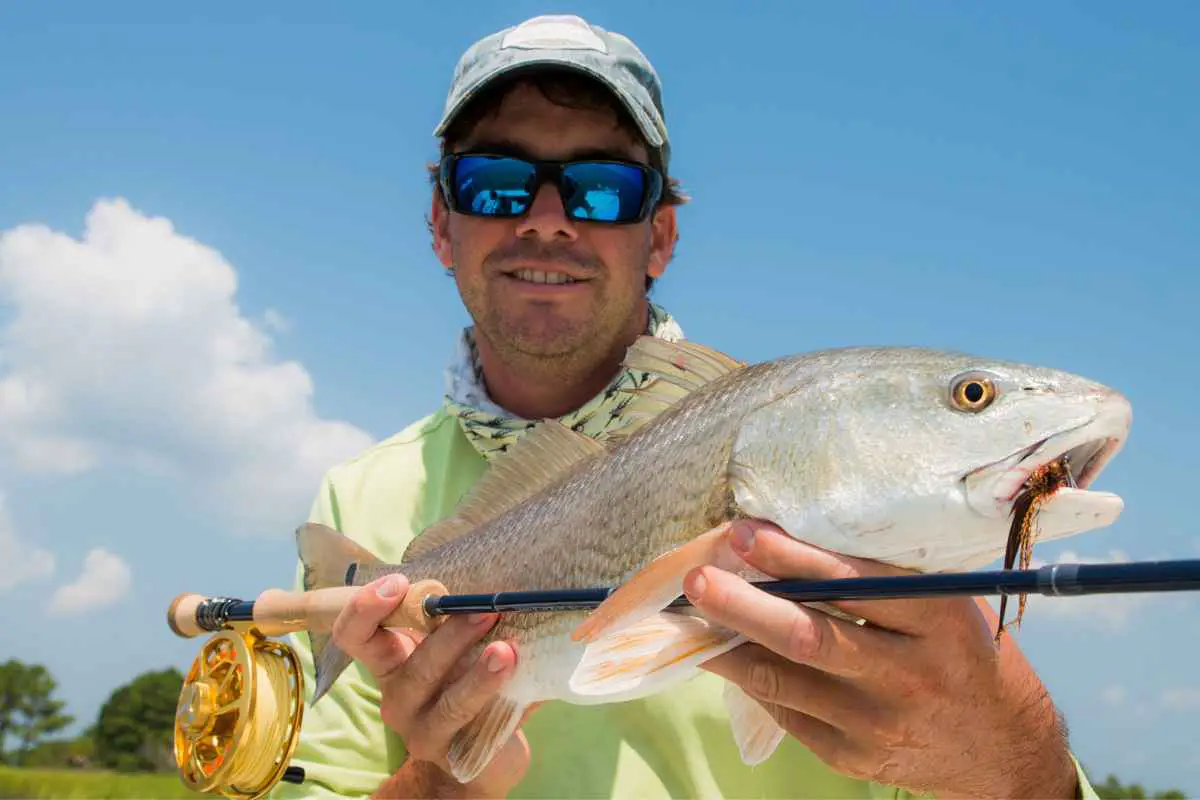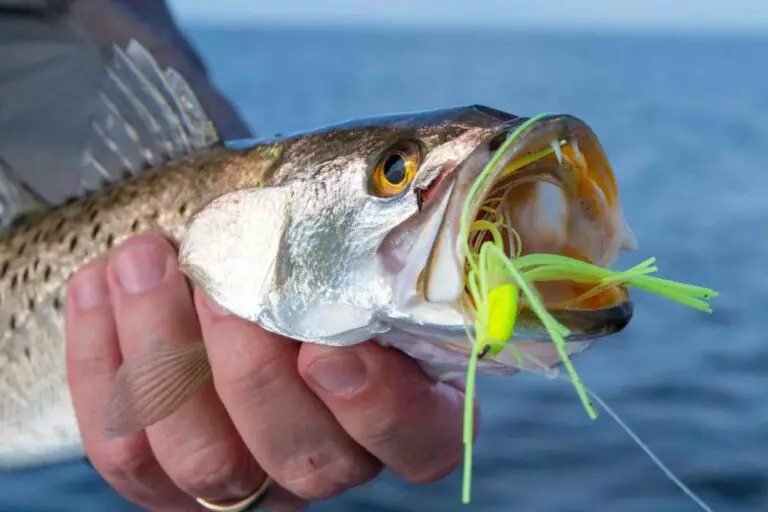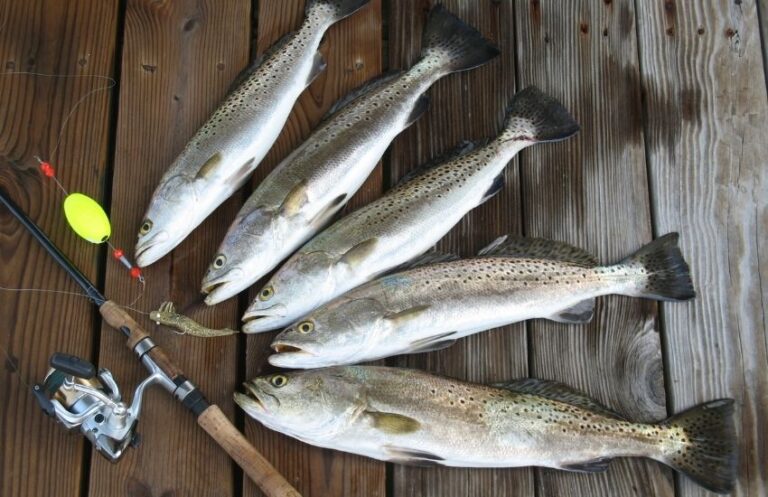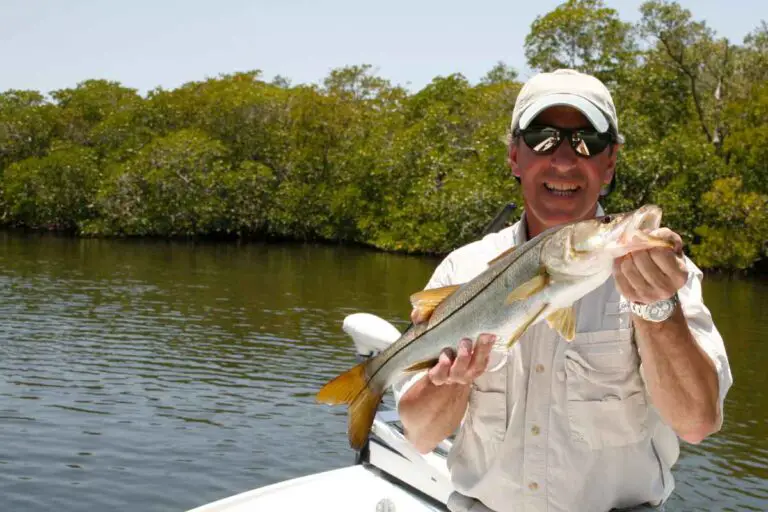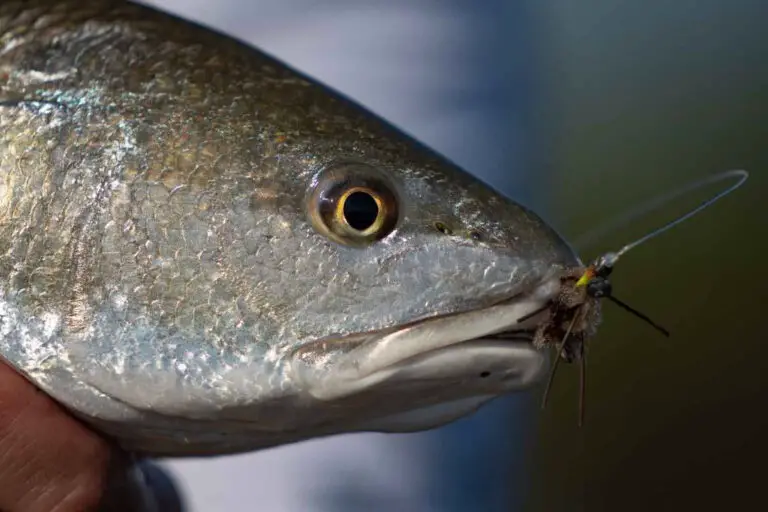North Carolina Saltwater Fishing Regulations [2023]: Top 47 Game Fish
Estimated reading time: 12 minutes
Are you getting ready for an amazing saltwater fishing adventure in North Carolina? If so, you’re in for a lot of fun! But, before you bait your hook, you should learn about the North Carolina Saltwater Fishing Regulations. These important rules, made by the North Carolina Department of Environmental Quality (NC DEQ) and the Wildlife Resources Commission, teach us how to fish in a way that keeps the ocean healthy. This includes having a fishing license, not catching too many fish, and following the NC saltwater fish size limits. That means some fish might be too small or too big to keep..
It’s important to keep up with these rules because they can change from time to time. These changes could be based on how many fish are in the ocean or what time of year it is. You can stay up-to-date by checking websites like the NC DEQ and the Wildlife Resources Commission. They share all the latest about the North Carolina coastal fishing regulations.
Remember, being ready for your fishing trip means knowing and following the rules. This helps us protect our ocean and ensure that everyone can enjoy fishing in the future!
North Carolina Saltwater Fishing Regulations
Size Limits
When fishing in North Carolina’s coastal waters, it’s important to understand and adhere to the North Carolina saltwater fish size limits. These limits, established by the North Carolina Division of Marine Fisheries, have been set to protect fish populations and maintain the health of marine fisheries and their habitats. There are some common saltwater fish that have specific size limits in North Carolina. They include:
- Black Drum: Minimum size of 14 inches TL
- Cobia: Minimum size of 36 inches TL when in season
- Red Drum: Minimum size of 18 inches TL
- Speckled Trout: Minimum size of 14 inches TL
- Striped Bass: Minimum size of 18-28 inches TL in certain areas
- Striped Mullet: No size limits, but regulations may vary
Ensure you are familiar with the size limits of the fish you intend to catch before heading out to fish. You can refer to the North Carolina Division of Marine Fisheries website for access to the most up-to-date and accurate information.
| Fish Species | Minimum Length | Bag Limits (per person) | Season / Rules |
|---|---|---|---|
| Alewife and Blueback Herring | Closed; No harvest allowed | Closed; No harvest allowed | Unlawful to take or possess |
| Amberjack, Greater | 36″ FL | Limit 1,200 pounds (gutted weight) per trip (Jan 1-Feb 28, Apr 1-Apr 30, Sep 1-Dec 31) 1/Day or trip (Jan 1-Mar 31, May 1-Dec 31) | Season open: May 1 – Dec 31 |
| American Eel | 9″ TL | 25/Day | Season open January 1 – August 31, except year-round when taken by baited pots. |
| Black Drum | 14-25″ TL | 10/Day | One black drum per person per day over 25” TL is allowed. |
| Black Sea Bass (North of Cape Hatteras) | 13″ TL | 15/Day | Season open May 15-Sept. 30 & Oct. 10-Dec. 31 |
| Black Sea Bass (South of Cape Hatteras) | 13″ TL | 7/Day | |
| Blue Marlin | 99″ LJFL | 1 per vessel per trip, either blue or white marlin | In state or federal waters, federal permit required for Highly Migratory Species, tunas, billfishes, swordfish and sharks (excluding Atlantic bonito, little tunny (false albacore), and blackfin tuna): https://hmspermits.noaa.gov/ 978-281-9370. Prior to removal from vessel, all billfishes, swordfish and bluefin tuna must be reported at NC HMS reporting stations. |
| Bluefish | None | 3/Day Recreational 5/Day For-Hire Vessel | |
| Cobia | 36″ FL (Commerical, Recreational) | 2/Day Commerical 6/Vessel/Day Commerical 1/Day Recreational *2/Vessel/Day Private **1/Vessel/Day Private | May 1, 2023 – Dec 31, 2023 (Commercial, Recreational) *May 1-Jun 30 2023 (Private Vessel) **Jul 1-Dec 31 2023 (Private Vessel) |
| Croaker | None | 50/Day | |
| Dolphin | None | 10/Day or 54 per trip, whichever is less. 10/Day Head Boats | |
| Flounder | CLOSED, UNLAWFUL TO POSSESS | CLOSED, UNLAWFUL TO POSSESS | No Recreational Flounder Season for 2023 as of yet. |
| Grouper, Black, Gag | 24″ TL | Limit 1,000 pounds (gutted weight) of gag grouper per trip. | Season open: May 1 – Dec 31 |
| Grouper, Rock Hind, Red Hind, Coney, Graysby | None | None | Season open: May 1 – Dec 31 |
| Grouper, Snowy | None | 200 pounds (gutted weight) of snowy grouper per trip. | Open season |
| Grouper, Speckled Hind, Warsaw, Nassau, Goliath | Closed; No harvest allowed | Closed; No harvest allowed | Unlawful to take or possess |
| Grouper, Yellowfin (fireback), Yellowmouth, Scamp | 20″ TL | None | Season open: May 1 – Dec 31 |
| King Mackerel | 24″ FL | 3/Day | Must be landed with head and fins intact. A person who is on a trip that spans more than 24 hours may possess no more than two daily bag limits, provided: such trip is aboard a vessel operating as a charter vessel or headboat; the vessel has two licensed operators aboard; and each passenger is issued and has in possession a receipt issued on behalf of the vessel that verifies the length of the trip. |
| Mullet (striped and white) | None | 200/Day (combined) | |
| Red Drum (Channel Bass, Puppy Drum) | 18-27″ TL | 1/Day | Unlawful to possess red drum greater than 27” TL. Unlawful to gig, spear, or gaff red drum. Size and creel limits for spotted seatrout, flounder, red drum and weakfish taken in inland waters are the same as the recreational limits for those species in adjacent joint and coastal waters. |
| Red Grouper | 20″ TL | 200 lbs gutted weight per trip | Season open: Jun 1 – Dec 31 |
| Sailfish | 63″ LJFL | 1/Day | In state or federal waters, federal permit required for Highly Migratory Species, tunas, billfishes, swordfish and sharks (excluding Atlantic bonito, little tunny (false albacore), and blackfin tuna): https://hmspermits.noaa.gov/ 978-281-9370. Prior to removal from vessel, all billfishes, swordfish and bluefin tuna must be reported at NC HMS reporting stations. |
| Scup (North of Cape Hatteras only) | 9″ TL | 40/Day | |
| Shad, American (All Other Internal Coastal and Joint Fishing Waters) | None | Ten (10) American shad or hickory shad in the aggregate, per person per day taken by hook-and-line or for recreational purposes and only one (1) of the ten (10) may be an American shad. | Feb 15 – Apr 14, 2023 (Commercial); Open season (Recreational) Apr 15 – Dec 31, 2023 Hook-and-line only (Recreational) |
| Shad, American (Atlantic Ocean) | Closed; No harvest allowed | Closed; No harvest allowed | Unlawful to take or possess American shad from the Atlantic Ocean |
| Shad, American (Cape Fear River) | None | Ten (10) American shad or hickory shad in the aggregate, per person per day taken by hook-and-line or for recreational purposes and only five (5) of the ten (10) may be an American shad. | Feb 20 – Apr 11, 2023 (Commercial); Open season (Recreational) |
| Shad, American (Pamlico and Pungo Rivers) | None | 10 American shad or hickory shad in the aggregate, per person per day | Feb 20 – Apr 11, 2023 (Commercial) Open season (Recreational) Hook-and-line only (Recreational) |
| Shad, Hickory (All Other Internal Coastal and Joint Fishing Waters) | None | Ten (10) American shad or hickory shad in the aggregate, per person per day taken by hook-and-line or for recreational purposes and only one (1) of the ten (10) may be an American shad. | Feb 15 – Apr 14, 2023 (Commercial); Open season (Recreational) Apr 15 – Dec 31, 2023 Hook-and-line only (Recreational) |
| Shad, Hickory (Atlantic Ocean) | None | 10 hickory shad in the aggregate, per person per day. | Jan 1 – Apr 14, 2023 (Commercial) Open season (Recreational) |
| Shad, Hickory (Cape Fear River) | None | Ten (10) American shad or hickory shad in the aggregate, per person per day taken by hook-and-line or for recreational purposes and only five (5) of the ten (10) may be an American shad. | Jan 1 – Apr 14, 2023 (Commercial); Open season (Recreational) |
| Sharks | See most recent DMF proclamations | See most recent DMF proclamations | In state or federal waters, federal permit required for Highly Migratory Species, tunas, billfishes, swordfish and sharks (excluding Atlantic bonito, little tunny (false albacore), and blackfin tuna): https://hmspermits.noaa.gov/ 978-281-9370. Prior to removal from vessel, all billfishes, swordfish and bluefin tuna must be reported at NC HMS reporting stations. |
| Sheepshead | 10″ FL | 10/Day | |
| Snappers, Groupers, Porgys, Triggerfish, Jacks, Tilefish, Grunts, Spadefishes, Wrasses and Sea Basses (H) | See the most recent Snapper/Grouper Complex recreational DMF proclamation | See the most recent Snapper/Grouper Complex recreational DMF proclamation | Federal Snapper/Grouper Complex Management |
| Spanish Mackerel | 12″ FL | 15/Day | Must be landed with head and fins intact. A person who is on a trip that spans more than 24 hours may possess no more than two daily bag limits, provided: such trip is aboard a vessel operating as a charter vessel or headboat; the vessel has two licensed operators aboard; and each passenger is issued and has in possession a receipt issued on behalf of the vessel that verifies the length of the trip. |
| Spiny Dogfish | None | None | |
| Spot | None | 50/Day | |
| Spotted Seatrout (Speckled Trout) | 14″ TL | 4/Day | Size and creel limits for spotted seatrout, flounder, red drum and weakfish taken in inland waters are the same as the recreational limits for those species in adjacent joint and coastal waters. |
| Striped Bass (Albemarle Sound) | 18-25″ TL | 1/Day | 12,804 pound quota; season closed if reached |
| Striped Bass (Atlantic Ocean) | 28-35″ TL | 1/Day | May – Oct: Landing tags required Circle hooks required with natural bait |
| Striped Bass (Cape Fear River) | Closed; No harvest allowed | Closed; No harvest allowed | Unlawful to take or possess |
| Striped Bass (Central Southern) | Closed; No harvest allowed | Closed; No harvest allowed | Unlawful to take or possess |
| Striped Bass (Roanoke River) | 18-22″ TL; 27″ Minimum | Contact the Wildlife Resources Commission | Federal Striped Bass Management |
| Tarpon | UNLAWFUL TO POSSESS | UNLAWFUL TO POSSESS | |
| Tuna: Bluefin, Bigeye and Yellowfin | Bigeye and Yellowfin Tuna – 27″ Curved FL | Yellowfin Tuna – 3/Day | In state or federal waters, federal permit required for Highly Migratory Species, tunas, billfishes, swordfish and sharks (excluding Atlantic bonito, little tunny (false albacore), and blackfin tuna): https://hmspermits.noaa.gov/ 978-281-9370. Prior to removal from vessel, all billfishes, swordfish and bluefin tuna must be reported at NC HMS reporting stations. |
| Wahoo | None | 2/Day | Must be landed with head and fins intact. |
| Weakfish (Gray Trout) | 12″ TL | 1/Day | Size and creel limits for spotted seatrout, flounder, red drum and weakfish taken in inland waters are the same as the recreational limits for those species in adjacent joint and coastal waters. |
| White Marlin | 66″ LJFL | 1 per vessel per trip, either blue or white marlin | In state or federal waters, federal permit required for Highly Migratory Species, tunas, billfishes, swordfish and sharks (excluding Atlantic bonito, little tunny (false albacore), and blackfin tuna): https://hmspermits.noaa.gov/ 978-281-9370. Prior to removal from vessel, all billfishes, swordfish and bluefin tuna must be reported at NC HMS reporting stations. |
Creel Limits
Creel limits, or bag limits, are established to help maintain fish populations and prevent overfishing. In North Carolina coastal waters, these limits vary depending on the habitat and the species, and here are a few examples:
- Black Drum: 10 fish per person per day
- Cobia: 1 fish per person per day (Recreational)
- Red Drum: 1 fish per person per day
- Speckled Trout: 4 fish per person per day
- Striped Bass: 1 fish per person per day in certain areas
- Striped Mullet: No daily bag limits, but regulations may vary
Please note that these above catch limits can change yearly or seasonally, so refer to the North Carolina Division of Marine Fisheries website for the most current recreational size and bag limits.
Seasons
Different fish species have specific seasons during which they can be caught in North Carolina’s coastal and inland waters both. Some popular saltwater fishing seasons include:
- Black Drum: Open year-round
- Cobia: May 1 – Dec 31 (Recreational, Commercial)
- Red Drum: Open year-round
- Speckled Trout: Open year-round
- Striped Bass: Open season May – Oct in certain areas, otherwise closed
- Striped Mullet: Open year-round
To ensure you adhere to the established regulations, being aware and staying up to date with the North Carolina fishing rules for the species you are targeting is crucial. Inland fishing regulations can be found on the Wildlife Resources Commission website or at 919-707-0220.
By following the North Carolina saltwater fishing regulations, you contribute to the long-term sustainability of fish populations and help maintain the quality of saltwater fishing experiences for residents and visitors alike.
How To Measure Your Catch
Measure Fish According to North Carolina Regulations
To measure a fish’s length, you’ll need a ruler or a tape measure that shows inches. When you take your measurement, round it down to the closest inch. Follow the steps that we mentioned earlier, using the NC saltwater fish size limits chart as your guide.
- Total Length (TL): Measured from the tip of the fish’s snout to the end of its tail.
- Fork Length (FL): Measured from the tip of the fish’s snout to where its tail splits or ‘forks’.
- Curved Fork Length (CFL): Measured along the fish’s body curve, from the top of the jaw to the fork in the tail.
- Lower Jaw Fork Length (LJFL): Measured from the tip of the fish’s lower jaw to the fork in the tail.
It’s important to measure your fish correctly so they meet the North Carolina saltwater fish size limits. If a fish is too small, you’ll need to let it go right away to avoid getting into trouble or having to pay a fine. Always check the newest rules before you go fishing so you’re sure to follow the law.
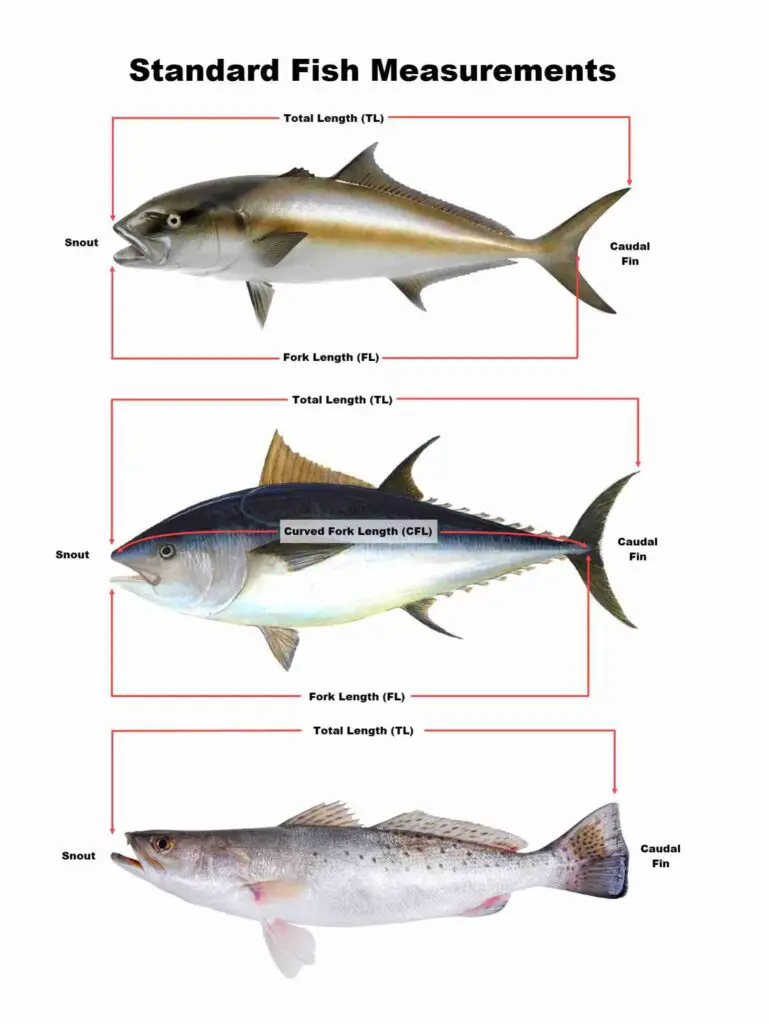
Fork Length vs. Total Length
When measuring fish in line with NC saltwater fish size limits, you’ll commonly use two types of measurements: fork length and total length. Fork length measures from the tip of the fish’s mouth to the split in its tail, while total length measures from the tip of the fish’s nose all the way to the tail’s end.
Grasping the difference between these two measurements is crucial because the size rule for a certain kind of fish might use either fork length or total length. To steer clear of breaking any rules and getting fined, make sure you check the rules for the specific type of fish you’re aiming to catch and measure your fish accurately.
Licenses and Permits
When fishing in North Carolina’s saltwater environments, it is essential to understand and comply with the relevant local laws and regulations. This section covers the necessary licenses and permits to participate in saltwater fishing activities.
| License Type | Duration | Resident Fee | Non-Resident Fee |
|---|---|---|---|
| Saltwater Licenses | |||
| Coastal Recreational Fishing License | 10-day | $5 | $10 |
| Coastal Recreational Fishing License | Annual | $15 | $30 |
| Coastal Recreational Fishing License | Lifetime | $250 | $500 |
| Freshwater Licenses | |||
| Inland Fishing License | 10-day | $5 | $10 |
| Inland Fishing License | Annual | $15 | $30 |
| Inland Fishing License | Lifetime | $250 | $500 |
| Combination Licenses | |||
| Unified Inland/Coastal Recreational | 10-day | $10 | $20 |
| Unified Inland/Coastal Recreational | Annual | $30 | $60 |
| Unified Inland/Coastal Recreational | Lifetime | $500 | $1,000 |
| Permits | |||
| Trout Fishing Permit | Annual | $10 | $10 |
Coastal Recreational Fishing License
If you’re 16 or older and want to fish for fun in any coastal or joint waters of North Carolina, you’ll need to get a Coastal Recreational Fishing License (CRFL). Here are some key points about this license:
- You can buy the CRFL for 10 days, for a year, or for your whole life.
- This license can be bundled with various hunting and inland fishing licenses from the Wildlife Resources Commission.
- The CRFL lets you fish for personal fun and non-commercial reasons.
Recreational Commercial Gear License
A Recreational Commercial Gear License is required for those who want to use specific commercial gear for recreational purposes, such as gill nets and crab pots. This fishing license only permits you to use certain commercial equipment in designated areas, ensuring you comply with North Carolina’s fishing regulations. Familiarize yourself with the specific equipment and locations this fishing license only covers before fishing.
| License Type | Duration | Resident Fee | Non-Resident Fee |
|---|---|---|---|
| Recreational Gear Licenses | |||
| Recreational Fishing Gear License | Annual | $35 | $70 |
| Commercial Gear Licenses | |||
| Commercial Fishing License | Annual | $400 | $800 |
| Shellfish License (Standard) | Annual | $250 | $500 |
| Shellfish License (Leaseholder) | Annual | $100 | $200 |
| Menhaden Purse Seine License | Annual | $1,000 | Not Available |
| Fish Dealer License | Annual | $100 | $200 |
Fishing licenses and permits help protect and conserve North Carolina’s invaluable marine resources. By following these regulations, you play a crucial role in permanently preserving the state’s diverse ecosystem for future generations.
Popular Saltwater Fish Species in North Carolina
Striped Bass
Striped bass is an exciting species to target in North Carolina’s inshore waters. With some fish reaching sizes of 30 plus pounds, you’ll experience an intense battle when hooking one. These fish can be found in the Roanoke River, with North Carolina boasting a great striped bass fishery.
Speckled Trout
Also known as spotted seatrout, speckled trout are common in inshore waters and estuaries. These enthusiasts’ favorites are celebrated for their aggressive strikes and acrobatic leaps upon hooking. Target speckled trout using live shrimp or soft plastic lures.
Flounder
Flounder, recognized by their distinctive flat bodies, are a treasured find for fishers along North Carolina’s coastline. You can usually spot these fish near structures and sandy sea floors. Using live bait like small fish and shrimp is a good way to attract flounder. At the moment, there’s no specific season set for catching flounder this year.
Black Drum
Black drum are another species worth chasing inshore. Renowned for their impressive size and feisty nature, they tend to hang out around pilings and wrecks, making them an exciting target. Black drum are known to put up quite a fight, tugging hard when hooked. Cut bait or shrimp are often used to successfully catch these robust swimmers.
Spanish Mackerel and King Mackerel
When it comes to mackerel, you can target both Spanish and King species inland fishing waters off the North Carolina coast. Spanish mackerel are plentiful inland fishing waters during summer, while King mackerel are often caught in coastal fishing waters in the fall. Trolling with live and artificial bait works well for these fast swimmers.
Sheepshead
Sheepshead inhabit structure-rich areas, especially near pilings and bridges. These toothy critters have a striped black and white appearance, making them easy to identify. Fiddler crabs and shrimp are effective bait options.
Tarpon
These incredible fighters are a thrilling species to hook off the Tarheel State’s coast. Known for their spectacular jumps, the tarpon is a must-target species for any serious angler. Use live and cut bait, or try tossing artificial lures for a challenging experience.
Cobia
Cobia are often found near structures like buoys, wrecks, and ledges. These powerful fish are a great sport and yield a tasty meal. Live bait, such as menhaden or mullet, tempts these bruisers into biting.
Bluefish
With the record for the largest Bluefish caught in North Carolina, this species is a popular target for saltwater anglers. Smaller bluefish are fun to fight, while larger ones offer a true challenge. Trolling with spoons or casting topwater lures can effectively target these relentless predators.
Spot
Spot is a great species for beginner anglers, as they’re prolific along the coast during late summer and fall. These small but feisty fish are usually found in large schools, making locating them easier. Bloodworms and shrimp are excellent bait options.
Sharks
Sharks can be found in the various waters off North Carolina, offering an adrenaline-pumping experience for anglers. Depending on the species, you can target them in inshore waters or venture further offshore. Shark fishing often involves deploying large baits and heavy tackle.
Mullet
Mullet are a popular baitfish for chasing larger predators but are also fun for light tackle action. You can often find schools of these agile swimmers in inshore waters during their fall migration. Cast nets and small hooks baited with bread or dough work well for these fish.
Other North Carolina Fishing Opportunities
Freshwater Fishing
North Carolina is a paradise for anglers, offering a wide variety of freshwater fishing opportunities. Here’s a quick rundown:
- Largemouth Bass: Thanks to the state’s effective F1 Largemouth Bass Stocking Program, these sought-after game fish thrive in locations such as Lake Chatuge and the Roanoke River.
- Catfish: Supported by the North Carolina Catfish Management Plan, catfish populations flourish in the state’s waters, along with other bottom-dwellers like carp and sturgeon.
- Trout: For those who prefer cooler climates, North Carolina’s mountain streams teem with brook, brown, and rainbow trout, offering fantastic fly fishing and lure casting opportunities.
Let’s take a look at some prime spots:
- Lake Chatuge: Nestled in the Blue Ridge Mountains, this beautiful reservoir is a favorite for bass fishing, catering to both novices and seasoned anglers.
- Roanoke River: Known for its striped bass population, especially during the spring and fall migration seasons, this river is ideal for angling enthusiasts.
For freshwater fishing in North Carolina, don’t forget you’ll need a valid license. It’s vital to follow the inland fishing regulations, which can be found in the North Carolina Regulations Digest or on the Wildlife Resources Commission website. By respecting the size, creel, and season limits, you’re promoting sustainable fishing and helping to keep these bountiful fishing opportunities available for future generations.
Resources and Additional Information
North Carolina Division of Marine Fisheries Website
To find the complete and most up-to-date information about North Carolina’s saltwater fishing regulations, visit the North Carolina Division of Marine Fisheries website. On their website, you can access information about:
- Recreational Size and Bag Limits: Information about various fish species’ size, creel, and season limits.
- Fishing Seasons & Rules: Get the latest regulatory updates and catch limits for the fishing season.
- Crab Regulations: Learn about the rules and regulations for crabbing in North Carolina’s coastal waters.
Remember to keep yourself informed, as regulations can change periodically. The website also provides helpful resources such as maps, news, and educational materials.
Local Fishing Guides
When planning your saltwater fishing trip, consider hiring a local fishing guide. They can:
- Provide expert knowledge on the best fishing spots, techniques, and species in season.
- Keep you updated on the latest regulations and catch limits, ensuring you stay within the legal boundaries while fishing.
- Organize and provide the necessary equipment, so you won’t have to worry about bringing your own gear.
To find a reputable fishing guide, ask for recommendations from local tackle shops or join online forums and social media groups focused on saltwater fishing in North Carolina.
Remember that fishing regulations are designed to protect our marine ecosystems, so always adhere to the guidelines and enjoy your fishing experience responsibly.
Conclusion
Explore North Carolina’s saltwater fishing regulations, size limits, and a wide range of popular saltwater fish species. With the ultimate guide at your disposal, you can embark on an exciting fishing adventure while following the rules and regulations to ensure sustainable fishing practices.
- Learn about the North Carolina saltwater fishing regulations, including size limits, creel limits, and seasons.
- Understand the Fork Length vs. Total Length measurement method for accurately measuring your catch.
- Obtain the necessary licenses and permits, such as the Coastal Recreational Fishing License or Recreational Commercial Gear License.
- Discover the popular saltwater fish species in North Carolina, including Striped Bass, Speckled Trout, Flounder, Black Drum, Spanish Mackerel, King Mackerel, Sheepshead, Tarpon, Cobia, Bluefish, Spot, Sharks, and Mullet.
- Explore other fishing opportunities, such as freshwater fishing, in North Carolina.
- Utilize resources like the North Carolina Division of Marine Fisheries website and seek guidance from local fishing guides for additional information and assistance.

